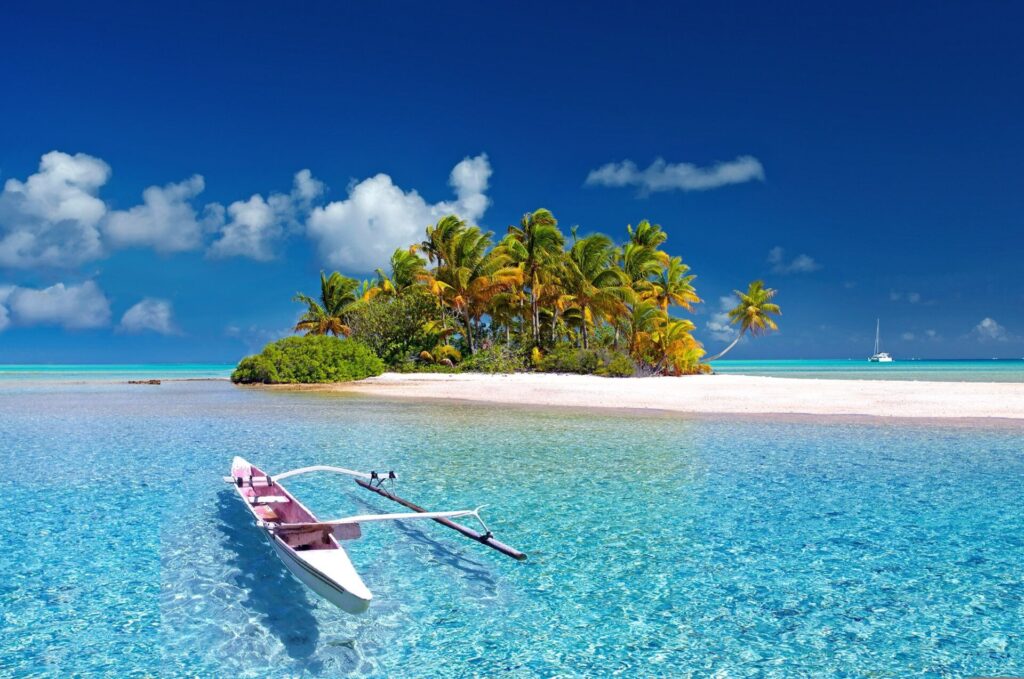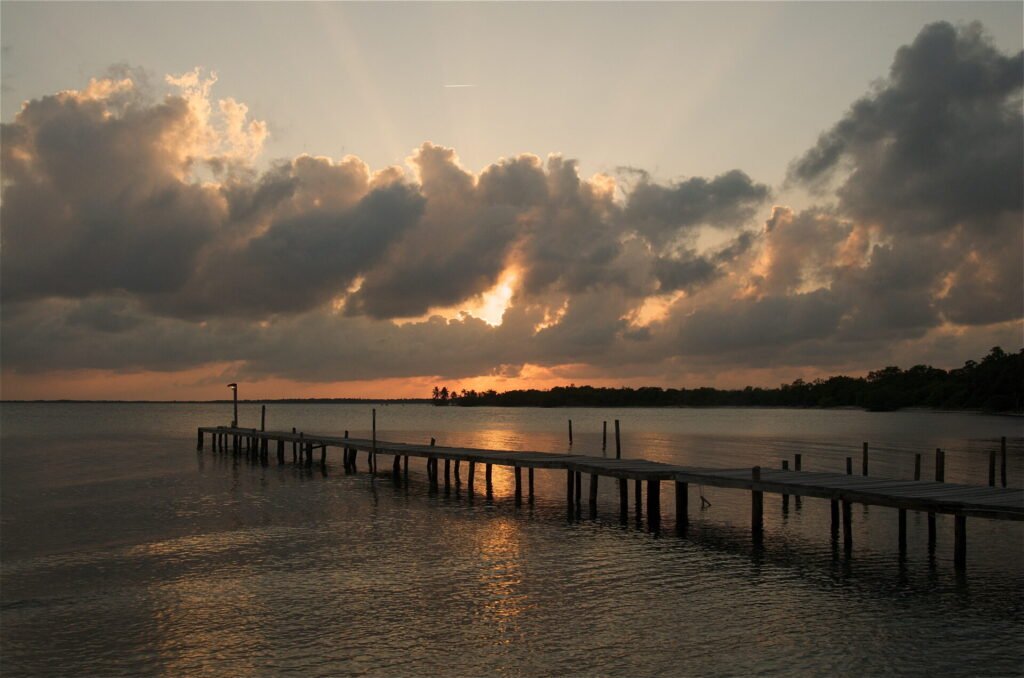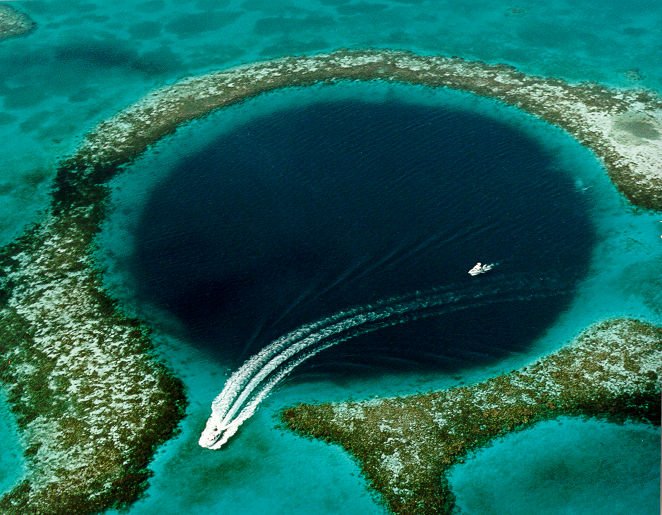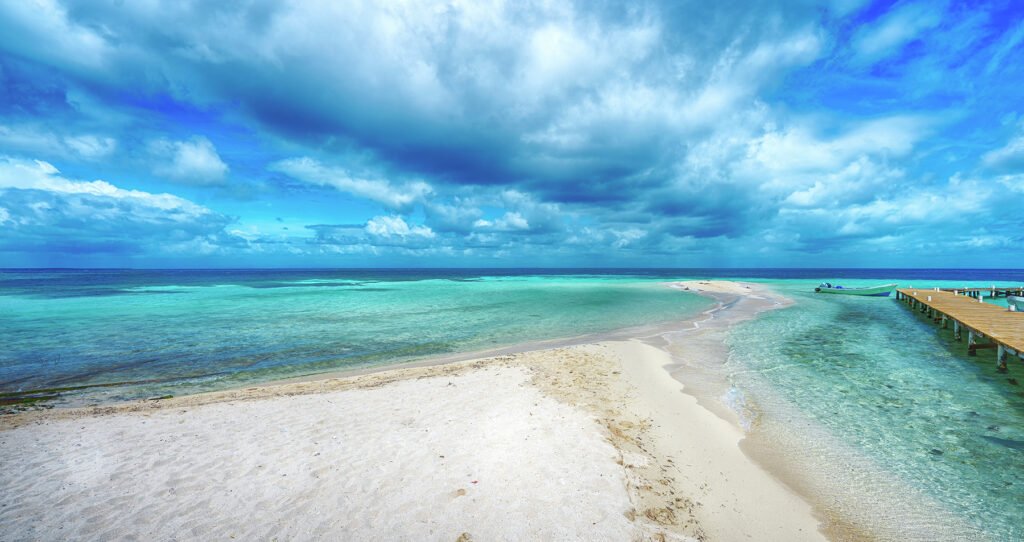It’s not the destination, It’s the journey. And in BELIZE it’s both!
Belize is a true Caribbean heaven, with shining beaches and waters in every shade of blue. The rich culture embraces all people with welcoming smiles. From island cays to mountain villages, Belize offers adventure, natural beauty, and warm hospitality. Belize has a very diverse culture with influences from the ancient Mayans who inhabited the land. Belize’s food, music, celebrations and way of life are famous in the whole world. It’s a paradise blessed by nature, made greater by its people. With kindness and open arms, Belize happily shares its national treasure with us.

Why Belize Snorkeling
- Belize is home to the Belize Barrier Reef, the second-largest barrier reef system in the world. It is a UNESCO World Heritage Site
- As a popular eco-tourism destination, Belize offers great snorkel tours, equipment rentals, dive shops, coastal accommodations, and island ferries. You can explore its underwater world with ease
- Belize snorkeling offers numerous great spots from beginner-friendly to more advanced
- Hundreds of cayes, three spectacular atolls, Island reefs and the massive barrier reef offers a memorable Belize snorkeling
- Belize is home to an incredibly diverse marine life thanks to major habitats like the Mesoamerican Barrier Reef, and the coastal mangrove forests. There are over 450 offshore, coral cayes or islands.
- You may spot damselfish, parrotfish, grunts, angelfish, triggerfish, wrasses, jacks, nurse sharks, reef sharks, hammerheads, whale sharks, Atlantic spotted dolphins, bottlenose dolphins along with stingrays while Belize snorkeling
Belize snorkeling map
- Belize is a small country located in Central America. It is bordered by Mexico to the north, Guatemala to the west and south, and the Caribbean Sea to the east
- The Belize Barrier Reef runs 185 miles of the country’s eastern coastline and is the largest reef system in the Northern Hemisphere
- Belize is home to numerous cayes (small islands) and atolls along its coastline
- Off the eastern coast, there are numerous cays, including Ambergris Caye, Caye Caulker, Goff’s Caye, Silk Cayes and Laughing Bird Caye
- Belize is also home to three atolls, which are ring-shaped coral reefs, including Turneffe Atoll, Lighthouse Reef Atoll, and Glover’s Reef Atoll

Belize Snorkeling spots
Belize is the second largest barrier reef in the world. It is stretching for 180 miles along its Caribbean coastline. It’s no wonder Belize is becoming one of the world’s top snorkeling destinations. Its blue waters are home to a variety of marine life just waiting to be discovered. We spotlight- The 11 Amazing Belize snorkeling spots not to miss in 2024:
1. Hol Chan Marine Reserve (Ambergris Caye)
- Hol Chan Marine Reserve is located off the southern tip of Ambergris Caye, the largest island in Belize
- Hol Chan, which means “Little Channel” in Mayan, was established as a marine reserve in 1987. It was the first marine reserve in Belize.
- It takes just a 15-20 minute boat ride from San Pedro to reach the site
- The reef’s diversity of hard and soft corals provides habitat for abundance of marine life
- Hol Chan Marine Reserve is one of the most popular guided Belize snorkeling sites
- You can look for designated snorkeling zones which prevents you from any damage from boats
- You can expect to see moray eels, large groupers, angelfish, parrotfish, sea turtles, nurse sharks, southern stingrays and much more.
How to Get There: Numerous dive shops in San Pedro town offer full and half-day snorkel trips. Alternately, independent travelers can take the ferry to Ambergris Caye, then arrange transportation to Hol Chan.
Where to Stay: For the easiest access, stay in San Pedro town on Ambergris Caye itself. Recommended areas include north Ambergris near the beach parks and southern end of town closer to the ferry terminal.
2. Mexico Rocks (Ambergris Caye)

- This protected reserve gets its name from its proximity to the Mexican border – just 4 miles away
- Mexico rock is situated to the north of Ambergris Caye
- The site is known for its shallow calm waters and a collection of coral formations, making it suitable for all skill levels of snorkeling
- Abundant marine life gather here around the underwater rock formations
- You may spot large groupers, angelfish, parrotfish, barracuda, sea turtles and spotted eagle rays among the many species found here. Occasionally, dolphins visit this snorkel spot too.
How to Get There: This spot can only be accessed by boat, so join a San Pedro snorkeling tour for transportation and equipment or charter a private boat from Ambergris Caye specifically for this location.
3. Shark Ray Alley
- Shark Ray Alley is located just one mile south of the Hol Chan Marine Reserve and listed under Zone 4 of it
- Shark Ray Alley get it’s name aptly as you can swim here with friendly nurse sharks, lemon sharks and occasionally blacktip reef Sharks
- A variety of habitats, including seagrass beds, coral reefs, and mangroves, contributing to the rich biodiversity of the area
- The sandbar at Shark Ray Alley sits in about 10 feet of water, allowing you to float at the surface and be at eye-level with all the underwater actions. The water is very calm and clear
- You may spot sea turtles, lobster, spotted eagle rays, and many species of reef fish
How to Get There: Belize Snorkeling tour boats depart from San Pedro, Caye Caulker, and Belize City to Ambergris Caye or Shark Ray Alley
3. Caye Caulker Marine Reserve

- The island of Caye Caulker, located just a quick water taxi ride from San Pedro,
- The waters around Caye Caulker are known for their coral gardens, vibrant marine life, and clear visibility
- The Caye Caulker Marine Reserve allows a section of rich reef accessible directly from the island’s shores
- Since the reserve is just off the coast of Caye Caulker island, So it’s a budget-friendly option to the more distant-Hol Chan Marine Reserve
- You may see colorful fish, sea turtles, stingrays, octopus and more.
- Coral Gardens is a popular snorkeling site here, known for bright varieties of ocean life including sea fans, brain corals, and plate corals.
How to Get There: Travel to Caye Caulker via ferry, then walk right into the warm shallow waters on the island’s west side or south side near the airstrip to access this self-guided snorkeling playground. You can also join a Caye Caulker snorkel tour for equipment and boat transport to other reef locations.
Where to Stay: Stay right on Caye Caulker itself for easy access to the Caye Caulker Marine Reserve’s shore snorkeling sites. The island has plenty of hotels, beach resorts, AirBnbs and hostels to choose from.
4. Turneffe Atoll

- Turneffe Atoll is the largest coral atoll in Belize and the Caribbean, located about 25 miles east of Belize City
- Over 500 patch reefs surround the 150+ mangrove islands that make up Turneffe Atoll
- This island is mostly uninhabited except for a couple of small fishing/tourism camps
- white sandy beaches with lots of stony and soft corals like brain, staghorn and massive star corals
- Turneffe Atoll has calm clear waters average around 60 feet deep, excellent visibility for experienced snorkelers
- You may spot eagle rays, permit fish, snappers, jacks, angelfish, parrotfish, lemon sharks and green turtle along Seagrass beds within the lagoon
How to Get There: It takes approx. 1.5 hours to reach to Turneffe Atoll from Belize city by boat
5. Gladden Spit & Silk Cayes Marine Reserve

- Gladden Spit is a small, sandy caye situated on the outer reef of the Belize Barrier Reef located about 25 miles off the Belize coast
- One of the main attractions at Gladden Spit is the annual whale shark aggregation that occurs during the months of March to June
- During this period, whale sharks, the world’s largest fish, gather near the reef to feed on the eggs of spawning fish, particularly snappers
- This seasonal snorkeling phenomenon runs March to June and provides a once-in-a-lifetime opportunity to swim along these gentle giants
- beautiful shallow reefs accessible year-round and features one of the Belize snorkeling for all skills level
- You may spot manta rays, eagle rays, and sea turtles
How to Get There: Multi-day liveaboard dive boats and snorkel tours from Placencia specifically target Gladden Spit during whale shark season. Day trips to Silk Cayes are also offered. Independent travel is not advised due to the offshore distance.
Where to Stay: While overnight liveaboards are an option, staying in Hopkins or Placencia allows you to join day trips to these snorkel sites then retreat to comfortable accommodation on land.
6. Bacalar Chico National Park & Marine Reserve

- Bacalar Chico is situated at the northern tip of Ambergris Caye, near the border with Mexico
- The marine reserve protects 196 square kilometers of coral reefs, seagrass beds, and mangrove forests
- Nearby Rocky Point hosts a spectacular 90-foot vertical wall filled with swim-throughs, tunnels, and caverns
- The Turtle Grass area features expansive sea grass beds that are inhabited by many sea horses and provide excellent shallow snorkeling
- You may spot Green and hawksbill turtles, stingrays, eagle rays, barracuda, and many juvenille fish
- A large crocodile population is found amongst the red, black, and white mangroves near the Bacalar Chico Visitor Center
Found at the northern tip of Ambergris Caye near the Mexican border, this national park protects part of the Belize Barrier Reef and encompasses both land and sea. Excellent reef diving and snorkeling can be enjoyed around Rocky Point and throughout the marine area with frequent sightings of green moray eels, nurse sharks, stingrays, turtles, large grouper and barracuda.
How to Get There: The Bacalar Chico visitor center and marine reserve is accessible by boat, with a handful of Ambergris Caye snorkel tour operators offering trips to this area, usually combined with other stops like Mexico Rocks or Cayo Frances Farm. You can also charter a private boat for a custom Bacalar Chico snorkel adventure.
7. South Water Caye Marine Reserve
- It is located 15-20 km east of Dangriga town on the central coast of Belize. The reserve passes South Water Caye and the surrounding waters
- South Water Caye Marine Reserve is the largest marine reserve in the Stann Creek district of Belize
- Snorkelers can explore rich marine life around patch reefs and the reef crest on the east side of South Water Caye. The west side has abundant conch, lobster and tropical fishes
- Colorful fish like parrotfish, angelfish, blue tang, and wrasses can be observed snorkeling along the impressive reef. Spotting green sea turtles, stingrays, and nurse sharks is also possible
How to Get There: Given its offshore location, the only way to access South Water Caye is via regularly scheduled snorkel or dive boat trips from Dangriga or Hopkins. Tours generally make 1-2 stops in the marine reserve for both snorkeling and beach time on the small islands.
Where to Stay: Choose accommodations in or near Hopkins or Dangriga for the shortest boat ride to South Water Caye and other offshore cayes. Both areas offer a variety of hotels, beach resorts, lodges and budget options.
8. Laughing Bird Caye National Park

- Laughing Bird Caye National Park is located just 11 miles off the coast from Placencia Village in the Stann Creek District of Belize
- It is an important habitat for many marine species and an area of spectacular natural beauty. It was designated a World Heritage Site by UNESCO in 1996
- This national park got its name from the Laughing Gull, which used to breed on the caye
- Over 73 species of hard and soft corals and more than 300 species of fish inhabit the area
- Laughing Bird Caye offers spectacular reef diving and snorkeling along the drop-offs encircling the island. Snorkelers can expect healthy coral, abundant tropical fish, sea turtles, eagle rays and sharks
How to Get There: Daily snorkeling trips to Laughing Bird Caye depart from Placencia year-round. The 45-minute to 1-hour boat ride each way is comfortably made via fast, covered tour boats. Independent travel is not advised
9. Lighthouse Reef Atoll & Blue Hole National Monument

- Located approximately 50 miles off the mainland coast of Belize and northeast of Belize City
- Great Blue Hole is a world-renowned circular underwater sinkhole measuring 984 feet across and 407 feet deep. It is a UNESCO World Heritage Site
- It was formed during past ice ages when sea levels were much lower. Stalactites found inside the sinkhole indicate its origins as a limestone cave on dry land before getting flooded as ice caps melted.
- This site is very popular for advanced scuba divers
- shallow Lighthouse Reef and nearby Half Moon Caye offers snorkeling opportunities for swimmers
- The reef walls swarm with marine life like grouper, angelfish, butterfly fish, turtles, tarpon and occasionally nurse sharks and hammerheads
How to Get There: Given the offshore location, the only way to visit Lighthouse Reef is via liveaboard dive boats or all-inclusive day trips from San Pedro or Caye Caulker. Snorkel/dive combo tours allow non-certified snorkelers to still experience these amazing outer atoll reef walls.
Where to Stay: Overnight diving liveaboards provide all-inclusive accommodation, while day trips allow you to stay on developed islands like Ambergris or Caye Caulker
10. Glover’s Reef Atoll Marine Reserve
- Glover’s Reef Atoll is the southernmost of the three atolls in Belize and is known for its pristine coral reefs and extensive seagrass beds
- A UNESCO World Heritage Site passes a stunning lagoon and over 700 patch healthy reefs
- The waters are always calm because of the protection of the reef
- Snorkelers can discover reef fish, Caribbean Spiny Lobster, Blue Tang, barracuda, white tip reef sharks, eagle rays, sea turtles and more
How to Get There: Glover’s remote location requires a liveaboard dive boat charter or long day trip from Dangriga, Hopkins or northern cayes like Ambergris Caye. Plan in advance and expect an early departure plus 2+ hours of boat transit each way.
Where to Stay: While multi-day liveaboard dive boats offer all-inclusive sleeping quarters, staying onshore allows you flexibility plus comfort back on land. Choose accommodations in Dangriga, Hopkins or San Pedro based on your trip origin point.
11. Goff’s Caye

- Goff’s Caye is a small, sandy, uninhabited island located off the coast of Belize, only 30 minutes boat ride away from Belize City
- It’s white sandy beach, and well developed coral reef formation are considered as a great Belize snorkeling spot
- Like many areas in Belize, Goff’s Caye boasts a rich marine biodiversity. Snorkelers may encounter a variety of coral formations, including brain coral and elkhorn coral and many reef fish
How to Get There: Many tour operators offer day trips to Goff’s Caye from Belize City
Belize Snorkeling tour FAQs:
Q: What is the best season to snorkel in Belize?
A: The best snorkeling conditions exist February through June with great water visibility plus calm seas. However, good snorkeling can be enjoyed year-round outside of storm season. For specific events like whale shark season, plan for early March to mid-June seasonality.
Q: Which spots are good for beginner snorkelers?
A: Shallow, protected reef areas like Mexico Rocks, Hol Chan Cut, Caye Caulker Marine Reserve and Bacalar Chico allow beginners to easily access colorful reef fish and marine life. Nurses sharks and stingrays found in spots like Shark Ray Alley get acclimated to snorkelers, offering rewarding first experiences.
Q: Where is the world’s second largest barrier reef?
A: Belize is home to the Mesoamerican Barrier Reef, the second largest barrier reef in the world after Australia’s Great Barrier Reef. Stretching the entire length of Belize’s eastern shoreline, it also continues north along Mexico’s Yucatan Peninsula coast and south to the Bay Islands of Honduras.
Q: What should I bring when snorkeling?
A: Essentials include a mask, snorkel and fins (usually provided by tours), swimsuit/sun protection, waterproof camera, sea sickness medicine if prone, towel/cover up and change of clothes for boat rides. Many snorkel locations are remote, so bring snacks/water if not provided. Don’t forget your passport when crossing into marine reserves!
Final word
Belize offers some of the best snorkeling in the Caribbean, thanks to its stunning barrier reef and hundreds of small islands and atolls. There are many fantastic snorkel sites to discover all along the Belize coastline from north to south. No matter where you choose to snorkel in Belize, you’ll be rewarded with warm waters bursting with marine life. I hope this Belize snorkeling blog has inspired you to take a dip yourself. Until the next underwater adventure, may the seas be as clear as our memories and the marine life as vibrant as our spirits. Safe travels and happy snorkeling!

